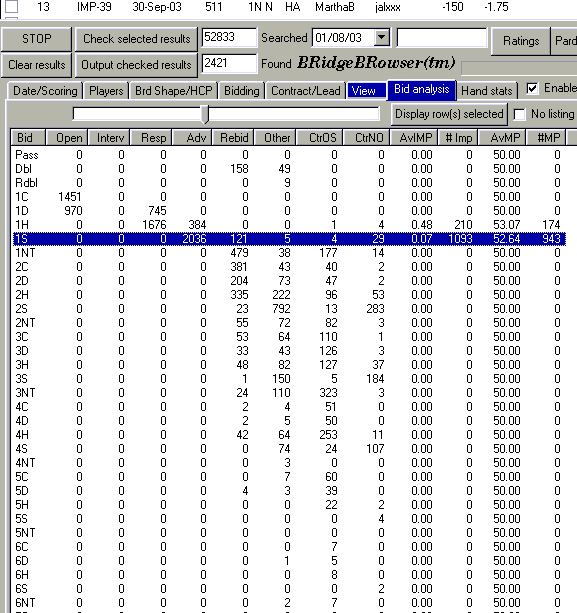| 7. Go back to Bidding tab, and press "Search" NOTE: each button labelled
"Search" is different. The one on the bidding tab searches by bid record
order, with any other terms marked (highlighted in blue on the tab header)
as secondary. Note that you can watch the engine cycle through the bidding
sequences in one of two ways:
a. You can look at the headings of the columns in this table change
as the sequences are tabulated.
b. You can watch the numbers cumulate in the Bid Analysis tab.
What you will notice is that within a given file (ie time period) you
first see all the hands where 1C was overcalled by 1D, ordered by time/date.
Next you will see the hands where 1C was overcalled by 1H, and so on, ending
with the hands that were opened 1H and overcalled 1S.
In addition, you can double click a hand as it scrolls by in the upper
box, to see if it fits the conditions you thought you just inserted. A
reality check! Given #6 above, the overcalling hand should always be at
the bottom of the screen.
NOTE 1 (I should have mentioned this before) you may order the
results by clicking any one of the columns on the main results window.
Experiment to see what happens if you click a column twice. If there are
lots of results (here it doesnt matter), it may go a little quicker if
you leave it unsorted - to do this simply click the column marked "Index".
NOTE 2 If this is taking too long (you have a slow connection),
you may want to stop the search. However note that your results will be
limited to the bidding sequences you already looked at. So it's not a particularly
good idea.
Let me give an example. Suppose you let it run through all the 1D overcalls
(the opening must, perforce, have been 1C) and now you see BRBR producing
records showing that the overcall is 1H. You press stop. The problem (not
insurmountable but this is left as an exercise for the experienced jockey)
is that in the column of 1C openers there are two kinds of hands, those
overcalled 1D and those overcalled 1H.
Not a problem, you say? Maybe not, but the general principle is that
BIDDING searches must be allowed to finish, particularly where the averages
in one cell in the Bid Analysis table (or Hand stats) contain more than
one bidding sequence. If not, the results may be badly biased since the
"higher" sequences are always missing (eg. the ones that end in grand slams).
NOTE 3 You may decide you don't want to slow up the search by
putting the individual hands in the main display. Simple go to the "Bid
Analysis" tab and check "No listing". This can safely be done in the middle
of a search.
If you decided that this is all too slow (running over the net), you
can
a. stop the search and try using the data as is (see the warnings above)
b. skip to part 2 of this article where the original
Frank Stewart question is examined - there's a lot less data to look at.
c. restrict your search to one of the overcalls only (eg 1C overcalled
by 1D. or direct overcalls of 1D,1H,1S after 1C opening).
d. get hold of a BRBR disk from us. Unfortunately we have to charge
(:
e. look at the summary of the results only. I have saved the spreadsheet
as
a .CSV file here
Most folks connected to the internet in USA and Canada, especially New
England, will find this to be easily fast enough, however. |


